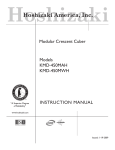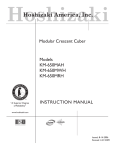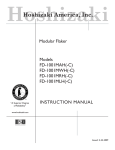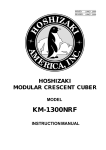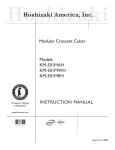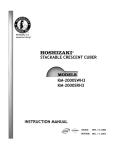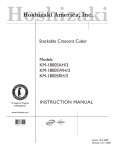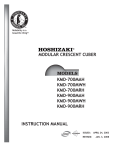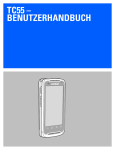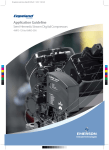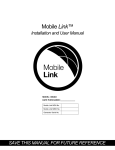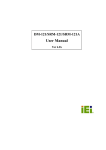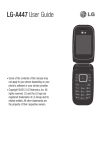Download Hoshizaki KMD-410MAH User's Manual
Transcript
Modular Crescent Cuber Models KMD-410MAH KMD-410MWH INSTRUCTION MANUAL Issued: 7-5-2013 IMPORTANT Only qualified service technicians should install and service the appliance. To obtain the name and phone number of your local Hoshizaki Certified Service Representative, visit www.hoshizaki.com. No installation or service should be undertaken until the technician has thoroughly read this Instruction Manual. Likewise, the owner/manager should not proceed to operate the appliance until the installer has instructed them on its proper operation. Failure to install, operate, and maintain the appliance in accordance with this manual will adversely affect safety, performance, component life, and warranty coverage and may result in costly water damage. Proper installation is the responsibility of the installer. Product failure or property damage due to improper installation is not covered under warranty. Hoshizaki provides this manual primarily to assist qualified service technicians in the installation, maintenance, and service of the product. Should the reader have any questions or concerns which have not been satisfactorily addressed, please call, write, or send an e-mail message to the Hoshizaki Technical Support Department for assistance. HOSHIZAKI AMERICA, INC. 618 Highway 74 South Peachtree City, GA 30269 Attn: Hoshizaki Technical Support Department Phone: 1-800-233-1940 Technical Support (770) 487-2331 Fax: 1-800-843-1056 (770) 487-3360 E-mail: [email protected] Web Site: www.hoshizaki.com NOTE: To expedite assistance, all correspondence/communication MUST include the following information: • Model Number • Serial Number • Complete and detailed explanation of the problem. 1 IMPORTANT This manual should be read carefully before the appliance is installed and operated. Read the warnings and guidelines contained in this manual carefully as they provide essential information for the continued safe use and maintenance of the appliance. Retain this manual for any further reference that may be necessary. CONTENTS PAGE Important Safety Information ---------------------------------------------------------------------------3 I. Specifications -------------------------------------------------------------------------------------------5 A. Electrical and Refrigerant Data -----------------------------------------------------------------5 B. Dimensions/Connections -------------------------------------------------------------------------6 1. KMD-410MAH -----------------------------------------------------------------------------------6 2. KMD-410MWH -----------------------------------------------------------------------------------7 II. Installation and Operating Instructions -----------------------------------------------------------8 A. Checks Before Installation -----------------------------------------------------------------------8 B. How to Remove Panels ---------------------------------------------------------------------------8 C. Location ----------------------------------------------------------------------------------------------9 D. Setup ------------------------------------------------------------------------------------------------ 10 E. Bin Control Installation -------------------------------------------------------------------------- 11 F. Electrical Connection ---------------------------------------------------------------------------- 14 G. Water Supply and Drain Connections ------------------------------------------------------ 15 1. Icemaker ---------------------------------------------------------------------------------------- 16 2. Water-Cooled Condenser ------------------------------------------------------------------- 17 H. Final Checklist ------------------------------------------------------------------------------------ 19 I. Startup ----------------------------------------------------------------------------------------------- 20 III. Cleaning and Maintenance Instructions ------------------------------------------------------ 21 A. Cleaning -------------------------------------------------------------------------------------------- 21 1. Cleaning Procedure -------------------------------------------------------------------------- 21 2. Sanitizing Procedure ------------------------------------------------------------------------- 25 B. Maintenance --------------------------------------------------------------------------------------- 26 1. Stainless Steel Exterior ---------------------------------------------------------------------- 26 2. Storage Bin and Scoop ---------------------------------------------------------------------- 26 3. Air Filters ---------------------------------------------------------------------------------------- 26 4. Condenser -------------------------------------------------------------------------------------- 26 C. Preparing the Icemaker for Periods of Non-Use ----------------------------------------- 27 IV. Disposal ----------------------------------------------------------------------------------------------- 28 2 Important Safety Information Throughout this manual, notices appear to bring your attention to situations which could result in death, serious injury, damage to the appliance, or damage to property. WARNING Indicates a hazardous situation which could result in death or serious injury. NOTICE Indicates a situation which could result in damage to the appliance or property. IMPORTANT Indicates important information about the installation, use and care of the appliance. WARNING The appliance should be destined only to the use for which it has been expressly conceived. Any other use should be considered improper and therefore dangerous. The manufacturer cannot be held responsible for injury or damage resulting from improper, incorrect, and unreasonable use. Failure to install, operate, and maintain the appliance in accordance with this manual will adversely affect safety, performance, component life, and warranty coverage and may result in costly water damage. To reduce the risk of death, electric shock, serious injury, or fire, follow basic precautions including the following: • Only qualified service technicians should install and service the appliance. • The appliance must be installed in accordance with applicable national, state, and local codes and regulations. • Electrical connection must be hard-wired and must meet national, state, and local electrical code requirements. Failure to meet these code requirements could result in death, electric shock, serious injury, fire, or damage. • The appliance requires an independent power supply of proper capacity. See the nameplate for electrical specifications. Failure to use an independent power supply of proper capacity can result in a tripped breaker, blown fuse, damage to existing wiring, or component failure. This could lead to heat generation or fire. • THE APPLIANCE MUST BE GROUNDED: Failure to properly ground the appliance could result in death or serious injury. • To reduce the risk of electric shock, do not touch the control switch with damp hands. • Move the control switch to the “OFF” position and turn off the power supply before servicing. Lockout/Tagout to prevent the power supply from being turned back on inadvertently. • Do not make any alterations to the appliance. Alterations could result in electric shock, injury, fire, or damage to the appliance. 3 WARNING, continued • The appliance is not intended for use by persons (including children) with reduced physical, sensory, or mental capabilities, or lack of experience and knowledge, unless they have been given supervision or instruction concerning use of the appliance by a person responsible for their safety. • Children should be properly supervised around the appliance. • Do not climb, stand, or hang on the appliance or allow children or animals to do so. Serious injury could occur or the appliance could be damaged. • Do not use combustible spray or place volatile or flammable substances near the appliance. They might catch fire. • Keep the area around the appliance clean. Dirt, dust, or insects in the appliance could cause harm to individuals or damage to the appliance. NOTICE • Protect the floor when moving the appliance to prevent damage to the floor. • Follow the water supply, drain connection, and maintenance instructions carefully to reduce the risk of costly water damage. • In areas where water damage is a concern, install in a contained area with a floor drain. • Install the appliance in a location that stays above freezing. Normal operating ambient temperature must be within 45°F to 100°F (7°C to 38°C). • Do not leave the appliance on during extended periods of non-use, extended absences, or in sub-freezing temperatures. To properly prepare the appliance for these occasions, follow the instructions in “III C. Preparing the Appliance for Periods of Non-Use.” • Keep ventilation openings, in the appliance enclosure or in the built-in structure, clear of obstruction. • Do not place objects on top of the appliance. • The dispenser unit/ice storage bin is for ice use only. Do not store anything else in the dispenser unit/ice storage bin. 4 I. Specifications A. Electrical and Refrigerant Data The nameplate provides electrical and refrigerant data. The nameplate is located on the right side panel. For certification marks, see the nameplate. We reserve the right to make changes in specifications and design without prior notice. Single Phase Model Number KMD-410MAH KMD-410MWH AC Supply Voltage 115/60/1 115/60/1 Compressor 115-120V 5.1RLA 50.0LRA 115V-120V 5.1RLA 50.0LRA Pump 120V 0.42FLA 23W 120V 0.42FLA 23W Fan 120V 0.50FLA 60W --- --- --- Other 115-120V 0.15A 115-120V 0.15A Maximum Fuse Size Max. HACR Breaker (USA Only) Max. Circuit Breaker (Canada Only) Minimum Circuit Ampacity 20 AMPS 20 AMPS 20 AMPS 20 AMPS 20 AMPS 20 AMPS 20 AMPS HI-467PSI LO-206PSI R404A 18.3 oz. 20 AMPS HI-467PSI LO-206PSI R404A 14.1 oz. Design Pressure Refrigerant 5 B. Dimensions/Connections 1. KMD-410MAH Unit: mm [inches] 6 2. KMD-410MWH Unit: mm [inches] 7 II. Installation and Operating Instructions WARNING • Install in accordance with all applicable national, state, and local codes and regulations. • CHOKING HAZARD: Ensure all components, fasteners, and thumbscrews are securely in place after installation. Make sure that none have fallen into the storage bin. A. Checks Before Installation NOTICE Remove all shipping cartons, tape, and packing material. If any are left in the icemaker, it will not work properly. • Visually inspect the exterior of the shipping container and immediately report any damage to the carrier. Upon opening the container, any concealed damage should also be immediately reported to the carrier. • Remove the panels to prevent damage when installing the icemaker. (See “B. How to Remove Panels.”) • Remove the package containing the accessories. • Remove the protective plastic film from the panels. If the icemaker is exposed to the sun or to heat, remove the film after the icemaker cools. • Check that refrigerant lines do not rub or touch lines or other surfaces, and that the fan blade turns freely. • Check that the compressor is snug on all mounting pads. • See the nameplate on the left or right side panel, and check that your voltage supplied corresponds with the voltage specified on the nameplate. • This icemaker can be installed on a storage bin or dispenser unit 22” wide or wider. If using a storage bin, HOSHIZAKI STORAGE BIN, Model B-300 series is recommended. B. How to Remove Panels - See Fig. 1 • Front Panel: Loosen the screws. Lift up and towards you. • Top Panel: Lift up at front slightly, push rearward and lift off. 8 • Side Panel (R): Remove the screw. Slide forward slightly and lift off. • Front Insulation: Lift up slightly, and pull towards you. • Top Insulation: Push up at front corner, and pop off. Top Panel Top Insulation Side Frame Front Insulation Front Panel Screw Side Panel Screws Fig. 1 C. Location NOTICE • This icemaker is not intended for outdoor use. Normal operating ambient temperature must be within 45°F to 100°F (7°C to 38°C); Normal operating water temperature must be within 45°F to 90°F (7°C to 32°C). Operation of the icemaker, for extended periods, outside of these normal temperature ranges may affect icemaker performance. • This icemaker will not work at sub-freezing temperatures. To prevent damage to the water supply line, drain the icemaker when the air temperature is below 32°F (0°C). See “III. C. Preparing the Icemaker for Periods of Non-Use.” For best operating results: • Icemaker should not be located next to ovens, grills, or other high heat producing equipment. 9 • In areas where water damage is a concern, install in a contained area with a floor drain. • Allow at least 6” (15 cm) clearance at the right side for proper air circulation and at least 12” (30 cm) clearance at top for ease of maintenance and/or service should they be required. • Location should provide a firm and level foundation for the equipment. D. Setup WARNING The installer must ensure the dispenser unit/ice storage bin is compatible with the icemaker, and the dispenser unit/ice storage bin and icemaker are properly attached and secured. NOTICE Do not use the side frame to lift the icemaker. See Fig. 1. Lift the icemaker from the base. 1a) Dispenser Unit: Follow the dispenser unit’s setup procedure. Icemaker 1b) Ice Storage Bin: Unpack the ice storage bin and attach the 4 adjustable legs provided (bin accessory) to the bottom of the ice storage bin. 2) Position the dispenser unit/ice storage bin in its permanent location. Mounting Brackets Bolts Bin 3) If required, install an adapter kit or top kit. Contact your local Hoshizaki distributor for recommendations. 4) Level the dispenser unit/ice storage bin in both the left-to-right and front-to-rear directions. If using an ice storage bin, adjust the ice storage bin legs to level. Fig. 2a 5) Place the icemaker on top of the dispenser unit/ice storage bin. 6a) Ice Storage Bin: Follow the ice storage bin, adapter kit, or top kit instructions for securing the icemaker. If no instructions are available, secure the icemaker using the 2 mounting brackets and the bolts provided. See Fig. 2a. 10 6b) Dispenser Unit: Follow the dispenser unit, adapter kit, or top kit instructions for securing the icemaker. If no instructions are available, secure the icemaker using the mounting brackets provided. Rotate the mounting brackets so that they fit flush to the dispenser unit. See Fig. 2b. Secure the mounting brackets to the icemaker with the bolts provided. Secure the mounting brackets to the dispenser unit with self-tapping screws (not provided). NOTICE! Use care to avoid damage to dispenser unit components when attaching the mounting brackets. Icemaker Mounting Brackets Bolts Self-tapping screws (not provided) Dispenser Fig. 2b E. Bin Control Installation 1) Remove the front panel, then remove the front insulation. Float Switch Connector 2) Loosen the two thumbscrews Discharge securing the pump motor bracket. Hose See Fig. 3. Pump Motor Connector 3) Disconnect the discharge hose. 4) D i s c o n n e c t t h e p u m p m o t o r connector and float switch connector from the side of the control box. Snap Tab Thumbscrews Pump Motor Bracket Fig. 3 5) While pushing up the snap tab at the right side of the pump motor bracket, pull out the water tank, cube guide, pump motor bracket, pump motor and float switch together. See Fig. 4. Pump Motor Float Switch Cube Guide 11 Snap Tab Fig. 4 6) Route the bin control lead through the hole in the base, then into the bushing provided. See Fig. 5. Bin Control Lead Bushing Fig. 5 7) While pulling up the bin control lead, hook the bin control on the right side interior wall. Then push the bin control up against the bottom of the unit, and slide to the back until it snaps in place. Make sure the slotted holes at the right side of the bin control are securely placed on the collars at the bottom of the unit. See Fig. 6. Collars Bin Control Fig. 6 NOTICE Make sure the bin control is securely in place. Otherwise, ice may get between gaps and damage the bin control. 8) Pull up any slack in the bin control lead, then put the bushing attached to the bin control lead back into the hole in the base. 9) Connect the bin control connector to the side of the control box. 10) Make sure the right and left deflectors are in their correct positions with the slotted holes engaged on the collars. Make sure the right and left deflectors are secured with the thumbscrews. See Fig. 7. 12 Right Deflector Left Deflector Thumbscrew Thumbscrew Collars (Behind Left Deflector) Collars Fig. 7 11) Replace the water tank, cube guide, pump motor bracket, pump motor and float switch in their correct positions until they snap in place. NOTICE Be sure to let the discharge hose pass behind the copper tube and connect it securely in position. See Fig. 3. Otherwise, the discharge hose may be caught in the front insulation, leading to improper results. 12) Secure the pump motor bracket with the two thumbscrews. 13) Reconnect the pump motor connector and float switch connector. 14) Replace the front insulation and front panel in their correct positions. 13 F. Electrical Connection WARNING • Electrical connection must be hard-wired and must meet national, state, and local electrical code requirements. Failure to meet these code requirements could result in death, electric shock, serious injury, fire, or damage. • The appliance requires an independent power supply of proper capacity. See the nameplate for electrical specifications. Failure to use an independent power supply of proper capacity can result in a tripped breaker, blown fuse, damage to existing wiring, or component failure. This could lead to heat generation or fire. • THE APPLIANCE MUST BE GROUNDED: Failure to properly ground the appliance could result in death or serious injury. • Electrical connection must be made in accordance with the instructions on the “WARNING” tag, provided with the pig tail leads in the junction box. See Fig. 8. • To reduce the risk of electric shock, do not touch the control switch with damp hands. • Usually an electrical permit and services of a licensed electrician are required. 8"3/*/( &-&$53*$"-$0//&$5*0/ • The maximum allowable voltage variation is ±10 percent of the nameplate rating. • The white lead must be connected to the neutral conductor of the power source. NOTICE! Miswiring may result in severe damage to the icemaker. See Fig. 8. 5)*46/*5.645#&(306/%&% 'BJMVSFUPQSPQFSMZHSPVOEPSXJSF UIJTVOJUDPVMESFTVMUJOEFBUI TFSJPVTJOKVSZPSTFWFSFEBNBHF UPUIFJDFNBLFS5IFXIJUFMFBE NVTUCFDPOOFDUFEUPUIFOFVUSBM DPOEVDUPSPGUIFQPXFSTPVSDF 4FFEJBHSBNCFMPX • The opening for the power supply connection is 7/8” DIA to fit a 1/2” trade size conduit. +6/$5*0/#09 7 - / #308/ 8)*5& " Fig. 8 14 G. Water Supply and Drain Connections - See Fig. 9, 10 or 11 WARNING Water supply and drain connections must be installed in accordance with applicable national, state, and local regulations. NOTICE • Normal operating water temperature should be within 45°F to 90°F (7°C to 32°C). Operation of the appliance, for extended periods, outside of this normal temperature range may affect appliance performance. • Water supply pressure must be a minimum of 10 PSIG and a maximum of 113 PSIG. If the pressure exceeds 113 PSIG, the use of a pressure reducing valve is required. • To prevent damage to the appliance, do not operate the appliance when the water supply is off, or if the pressure is below 10 PSIG. Do not run the appliance until the proper water pressure is reached. • External filters, strainers, or softeners may be required depending on water quality. Contact your local Hoshizaki Certified Service Representative or local Hoshizaki distributor for recommendations. • A plumbing permit and services of a licensed plumber may be required in some areas. • The icemaker drain line, dispenser unit/storage bin drain line, and water-cooled condenser drain line (if applicable) must be run separately. • Drain lines must have 1/4” fall per foot (2 cm per 1 m) on horizontal runs to get a good flow. A vented tee connection is also required for proper flow. • Drain lines should not be piped directly to the sewer system. An air gap of a minimum of 2 vertical inches (5 cm) should be between the end of the drain pipes from the icemaker, dispenser unit/storage bin, and water-cooled condenser (if applicable) and the floor drain. 15 1. Icemaker Icemaker Water Supply Inlet 1/2" Female Pipe Thread (FPT) Minimum Icemaker Water Supply Line Size 1/4" Nominal ID Copper Water Tubing or Equivalent Icemaker Drain Outlet 3/4" Female Pipe Thread (FPT) Minimum Icemaker Drain Line Size 3/4" Nominal ID Hard Pipe or Equivalent • An icemaker water supply line shut-off valve and drain valve must be installed. • Be sure there is sufficient extra water supply line and drain line for the appliance to be pulled out for service. Minimum 1/4” Nominal ID Copper Water Tubing Icemaker Water Supply Inlet 1/2” FPT Icemaker Water Supply Line Shut-Off Valve Icemaker Icemaker Water Supply Line Drain Valve Icemaker Drain Outlet 3/4” FPT Vent Tube Bin Bin Drain Outlet 3/4”FPT Vent Tube Floor Drain Fig. 9 16 Separate piping to approved drain. Leave a 2-inch (5-cm) vertical air gap between the end of each pipe and the drain. 2-inch (5-cm) air gap Minimum 3/4” Nominal ID Hard Pipe KMD-410MAH Be sure there is sufficient extra water supply line and drain line for the appliance to be pulled out for service. 2. Water-Cooled Condenser a) Connection to an Open Drain System Condenser Water Minimum Condenser Supply Inlet Water Supply Line Size 1/2" Female Pipe 1/4" Nominal ID Copper Thread (FPT) Water Tubing or Equivalent Condenser Drain Outlet 1/2" Female Pipe Thread (FPT) Minimum Condenser Drain Line Size 1/4" Nominal ID Hard Pipe or Equivalent • A condenser water supply line shut-off valve and drain valve must be installed. • In some areas, a back flow preventer may be required in the cooling water circuit. • In order to maintain the proper high side pressure, the condenser water supply inlet temperature must be in the 45°F to 90°F (7°C to 32°C) range. Icemaker Water Supply Inlet 1/2” FPT Minimum 1/4” Nominal ID Copper Water Tubing Condenser Drain Outlet 1/2” FPT Icemaker Water Supply Line Shut-Off Valve Condenser Water Supply Inlet 1/2” FPT Condenser Water Supply Line Shut-Off Valve Icemaker Icemaker Water Supply Line Drain Valve Icemaker Drain Outlet 3/4” FPT Condenser Water Supply Line Drain Valve Be sure there is sufficient extra water supply line and drain line Vent Tube for the appliance to be pulled out for service. Minimum 3/4” Nominal ID Separate piping to approved Hard Pipe drain. Leave a 2-inch (5-cm) vertical air gap between the 2-inch end of each pipe and the drain. (5-cm) air gap Bin Bin Drain Outlet 3/4” FPT Minimum 1/4” Nominal ID Hard Pipe Floor KMD-410MWH Connection to an Open Drain System Drain Fig. 10 17 b) Connection to a Closed Loop System Condenser Water Minimum Condenser Condenser Minimum Condenser Supply Inlet Water Supply Line Size Return Outlet Return Line Size 1/2" Female Pipe 1/4" Nominal ID Copper 1/2" Female Pipe 1/4" Nominal ID Copper Thread (FPT) Water Tubing or Equivalent Thread (FPT) Water Tubing or Equivalent • Shut-off valves and drain valves must be installed at both the condenser water supply inlet and condenser return outlet. • Minimum water flow to the condenser is 4 GPM. • The pressure differential between the condenser water supply inlet and condenser return outlet must be no less than 10 PSIG. • When using a glycol blend, the solution mixture should be less than 30% glycol. • In order to maintain the proper high side pressure, the condenser water supply inlet temperature must be in the 45°F to 90°F (7°C to 32°C) range. Icemaker Water Supply Inlet 1/2” FPT Minimum 1/4” Nominal ID Copper Water Tubing Icemaker Water Supply Line Shut-Off Valve Condenser Return Outlet 1/2” FPT Condenser Return Line Shut-Off Valve Condenser Water Supply Inlet 1/2” FPT Condenser Water Supply Line Shut-Off Valve Icemaker Icemaker Water Supply Line Drain Valve Icemaker Drain Outlet 3/4” FPT Condenser Return Line Drain Valve Bin Bin Drain Outlet 3/4” FPT Condenser Water Supply Line Drain Valve Be sure there is sufficient extra Vent Tube water supply line and drain line for the appliance to be pulled out for service. 2-inch (5-cm) air gap Minimum 3/4” Nominal ID Hard Pipe KMD-410MWH Connection to a Closed Loop System Floor Fig. 11 Drain 18 Separate piping to approved drain. Leave a 2-inch (5-cm) vertical air gap between the end of each pipe and the drain. H. Final Checklist WARNING CHOKING HAZARD: Ensure all components, fasteners, and thumbscrews are securely in place after installation. Make sure that none have fallen into the dispenser unit/ice storage bin. 1) Is the icemaker level? 2) Is the icemaker in a site where the ambient temperature is within 45°F to 100°F (7°C to 38°C) and the water temperature within 45°F to 90°F (7°C to 32°C) all year around? 3) Is there at least 6” (15 cm) clearance at the right side for proper air circulation and at least 12” (30 cm) clearance at top for ease of maintenance and/or service? 4) Have all shipping cartons, tape, and packing material been removed from the icemaker? Is the cube guide in the correct position? 5) Have all electrical and water connections been made? Do electrical and water connections meet all national, state, and local code and regulation requirements? 6) Has the power supply voltage been checked or tested against the nameplate rating? Has a proper ground been installed to the icemaker? 7) Are the water supply and drain lines sized as specified? Are the water supply line shut-off valve(s) and drain valve(s) installed? Has the water supply pressure been checked to ensure a minimum of 10 PSIG and a maximum of 113 PSIG? 8) Is the compressor snug on all mounting pads? Have the refrigerant lines been checked to make sure they do not rub or touch other lines or surfaces? Has the fan blade (if applicable) been checked to make sure it turns freely? 9) Are all components, fasteners, and thumbscrews securely in place? 10) Has the end user been given the instruction manual, and instructed on how to operate the icemaker and the importance of the recommended periodic maintenance? 11) Has the end user been given the name and telephone number of an authorized service agent? 12) Has the warranty card been filled out and forwarded to the factory for warranty registration? 19 I. Startup WARNING All parts are factory-adjusted. Improper adjustments may adversely affect safety, performance, component life, and warranty coverage. NOTICE • If the unit is turned off, wait for at least 3 minutes before restarting the icemaker to prevent damage to the compressor. • To prevent damage to the water pump, do not leave the control switch in the “SERVICE” position for extended periods of time when the water tank is empty. • At startup, confirm that all internal and external connections are free of leaks. 1) Open the water supply line shut-off valve. 2) Remove the front panel. 3) Move the control switch on the control box to the “ICE” position. 4) Replace the front panel in its correct position. 5) Turn on the power supply and allow the icemaker to operate for 5 minutes to fill up the water tank. 6) Remove the front panel and move the control switch to the “SERVICE” position. Move the service switch to the “WASH” position. 7) Replace the front panel in its correct position and allow the icemaker to run for 5 minutes. 8) Remove the front panel and move the service switch to the “DRAIN” position. 9) Replace the front panel in its correct position and allow the icemaker to drain for 2 minutes. 10) Turn off the power supply. 11) Remove the front panel and move the control switch to the “ICE” position. 12) Replace the front panel in its correct position. 13) Clean the storage bin/dispenser unit liner using a neutral cleaner. Rinse thoroughly after cleaning. 20 14) Turn on the power supply to start the automatic icemaking process. 15) To confirm bin control operation, press the bin control’s actuator paddle during the first 5 minutes of the freeze cycle. The compressor and fan motor should de-energize within 15 seconds, then the drain valve should energize until the water tank empties. After the water tank empties, the pump motor and drain valve should de-energize. III. Cleaning and Maintenance Instructions WARNING CHOKING HAZARD: Ensure all components, fasteners, and thumbscrews are securely in place after any cleaning or maintenance is done to the unit. Make sure that none have fallen into the dispenser unit/storage bin. A. Cleaning HOSHIZAKI recommends cleaning this unit at least once a year. More frequent cleaning, however, may be required in some existing water conditions. WARNING • To prevent injury to individuals and damage to the icemaker, do not use ammonia type cleaners. • Carefully follow any instructions provided with the bottles of cleaning and sanitizing solution. • Always wear liquid-proof gloves to prevent the cleaning and sanitizing solutions from coming into contact with skin. NOTICE To prevent damage to the water pump, do not leave the control switch in the “SERVICE” position for extended periods of time when the water tank is empty. 1. Cleaning Procedure 1) Dilute approximately 9.5 fl. oz. (281 ml) of Hoshizaki “Scale Away” with 1.8 gallon (6.8 lit.) of warm water. 2) Remove all ice from the evaporator and the storage bin/dispenser unit. Note: To remove cubes on the evaporator, turn off the power supply and turn it on after 3 minutes. The harvest cycle starts and the cubes will be removed from the evaporator. 21 3) Turn off the power supply. 4) Remove the front panel and move the control switch to the “SERVICE” position. Move the service switch to the “DRAIN” position. 5) Replace the front panel in its correct position and turn on the power supply for 2 minutes. 6) Turn off the power supply. 7) Remove the front panel then remove the front insulation (the large insulation panel in front of the evaporator) by lifting up the panel slightly and pulling it towards you. 8) In bad or severe water conditions, clean the float switch as described below. Otherwise, continue to step 9. a. Loosen the two thumbscrews securing the pump motor bracket. See Fig. 12. b. Disconnect the discharge hose. c. Disconnect the pump motor connector and the float switch connector from the side of the control box. d. While pushing up the snap tab at the right side of the pump motor bracket, pull out the water tank, cube guide, pump motor bracket, pump motor and float switch together. See Fig. 13. e. Remove the pump motor bracket securing the pump motor and the float switch. Remove the float switch from the pump motor bracket. f. Wipe down the float switch housing, shaft and float with cleaning solution. Rinse the parts thoroughly with clean water. g. Replace the float switch in its correct position. h. Replace the removed parts in the reverse order of which they were removed. 22 NOTICE Be sure to let the discharge hose pass behind the copper tube and connect it securely in position. See Fig. 12. Otherwise, the discharge hose may be caught in the front insulation, leading to improper results. Float Switch Connector Discharge Hose Pump Motor Connector Snap Tab Thumbscrews Pump Motor Bracket Fig. 12 Pump Motor Float Switch Snap Tab Cube Guide Fig. 13 9) Pour the cleaning solution into the water tank. 10) Move the service switch to the "WASH" position. 11) Replace the front insulation and the front panel in their correct positions. 23 12) Turn on the power supply to start the washing process. 13) Turn off the power supply after 30 minutes. 14) Remove the front panel. 15) Move the service switch to the "DRAIN" position. 16) Replace the front panel in its correct position and turn on the power supply for 2 minutes. 17) Turn off the power supply and remove the front panel. 18) Move the control switch to the "ICE" position. 19) Replace the front panel in its correct position. 20) Turn on the power supply to fill the water tank with water. 21) Turn off the power supply after 3 minutes. 22) Remove the front panel. 23) Move the control switch to the "SERVICE" position. Move the service switch to the "WASH" position. 24) Replace the front panel in its correct position. 25) Turn on the power supply to rinse off the cleaning solution. 26) Turn off the power supply after 5 minutes. 27) Remove the front panel. 28) Move the service switch to the "DRAIN" position. 29) Replace the front panel in its correct position and turn on the power supply for 2 minutes. 30) Turn off the power supply. 31) Remove the front panel. 32) Repeat steps 18 through 31 three more times to rinse thoroughly. Note: If you do not sanitize the icemaker, go to step 14 in "Sanitizing Procedure." 24 2. Sanitizing Procedure - Following Cleaning Procedure 1) Dilute a 5.25% sodium hypochlorite solution (chlorine bleach) with water (add approximately 0.9 fl. oz. (27 ml) to 1.8 gal. (6.8 lit.) of water). 2) Remove the front insulation. 3) Pour the sanitizing solution into the water tank. 4) Move the service switch to the "WASH" position. 5) Replace the front insulation and the front panel in their correct positions. 6) Turn on the power supply to start the sanitizing process. 7) Turn off the power supply after 15 minutes. 8) Remove the front panel. 9) Move the service switch to the "DRAIN" position. 10) Replace the front panel in its correct position and turn on the power supply for 2 minutes. 11) Turn off the power supply. 12) Remove the front panel. 13) Repeat steps 18 through 31 in "1. Cleaning Procedure" two times to rinse thoroughly. 14) Move the control switch to the "ICE" position. 15) Replace the front panel in its correct position. 16) Clean the storage bin/dispenser unit liner using a neutral cleaner. Rinse thoroughly after cleaning. 17) Turn on the power supply to start the automatic icemaking process. 25 B. Maintenance This icemaker must be maintained individually, referring to the instruction manual and labels provided with the icemaker. WARNING • Only qualified service technicians should service this icemaker. • To reduce the risk of electric shock, do not touch the control switch with damp hands. • Move the control switch to the “OFF” position and turn off the power supply before servicing. Lockout/Tagout to prevent the power supply from being turned back on inadvertently. • CHOKING HAZARD: Ensure all components, fasteners, and thumbscrews are securely in place after any maintenance is done to the appliance. Make sure that none have fallen into the dispenser unit/ice storage bin. 1. Stainless Steel Exterior To prevent corrosion, wipe the exterior occasionally with a clean, soft cloth. Use a damp cloth containing a neutral cleaner to wipe off oil or dirt build up. 2. Storage Bin and Scoop • Wash your hands before removing ice. Use the plastic scoop provided (bin accessory). • The storage bin/dispenser unit is for ice use only. Do not store anything else in the storage bin/dispenser unit. • Clean the scoop and the storage bin/dispenser unit liner using a neutral cleaner. Rinse thoroughly after cleaning. 3. Air Filters (air-cooled model only) Plastic mesh air filters remove dirt and dust from the air, and keep the condenser from getting clogged. As the filters get clogged, the icemaker’s performance will be reduced. Check the filters at least twice a month. When clogged, use warm water and a neutral cleaner to wash the filters. 4. Condenser (air-cooled model only) Check the condenser once a year, and clean if required by using a brush or vacuum cleaner. More frequent cleaning may be required depending on the location. 26 C. Preparing the Icemaker for Periods of Non-Use NOTICE • During extended periods of non-use, extended absences, or in sub-freezing temperatures, follow the instructions below to reduce the risk of costly water damage. • To prevent damage to the water pump, do not leave the control switch in the “SERVICE” position for extended periods of time when the water tank is empty. During extended periods of non-use, extended absences, or in sub-freezing temperatures, follow the instructions below. When the appliance is not used for two or three days under normal conditions, it is sufficient to move the control switch to the “OFF” position. 1. Remove the water from the icemaker water supply line: 1) Turn off the power supply and remove the front panel. 2) Move the control switch on the control box to the “OFF” position. 3) Close the icemaker water supply line shut-off valve and open the icemaker water supply line drain valve. See Fig. 9, 10 or 11. 4) Allow the line to drain by gravity. 5) Attach compressed air or carbon dioxide supply to the icemaker water supply line drain valve. 6) Move the control switch to the “ICE” position. 7) Replace the front panel in its correct position and turn on the power supply. 8) Quickly blow the icemaker water supply line out using compressed air or carbon dioxide. 2. Drain the water tank: 1) Move the service switch to the “DRAIN” position and move the control switch to the “SERVICE” position. 2) Replace the front panel in its correct position and turn on the power supply for 2 minutes. 3) Turn off the power supply and remove the front panel. 4) Move the control switch to the “OFF” position. 27 5) Replace the front panel in its correct position. 6) Remove all ice from the dispenser unit/storage bin. Clean the dispenser unit/storage bin using a neutral cleaner. Rinse thoroughly after cleaning. 7) Close the icemaker water supply line drain valve. 3. On water-cooled model only, remove the water from the water-cooled condenser: 1) Turn off the power supply and remove the front panel. 2) Move the control switch on the control box to the “OFF” position. 3) Remove the top panel and right side panel. 4) Close the condenser water supply line shut-off valve. If connected to a closed loop system, also close the condenser return line shut-off valve. See Fig. 10 or 11. 5) Open the condenser water supply line drain valve. If connected to a closed loop system, also open the condenser return line drain valve. 6) Attach a compressed air or carbon dioxide supply to the condenser water supply line drain valve. 7) Open the water regulating valve by using a screwdriver to pry up on the spring retainer underneath the spring. While holding the valve open, blow out the condenser using the compressed air or carbon dioxide supply until water stops coming out. Note: Be sure to close the water regulating valve as before. 8) Close the condenser water supply line drain valve. If connected to a closed loop system, also close the condenser return line drain valve. 9) Replace the top, right side, and front panels in their correct positions. IV. Disposal The appliance contains refrigerant and must be disposed of in accordance with applicable national, state, and local codes and regulations. Refrigerant must be recovered by properly certified service personnel. IMPORTANT The insulation foaming agent used for the unit body contains flammable gas cyclopentane. With this in mind, dispose of the product properly. 28 HOSHIZAKI AMERICA, INC. 618 Hwy. 74 S., Peachtree City, GA 30269 USA TEL (770) 487-2331 FAX (770) 487-3360 www.hoshizaki.com L1F043104































